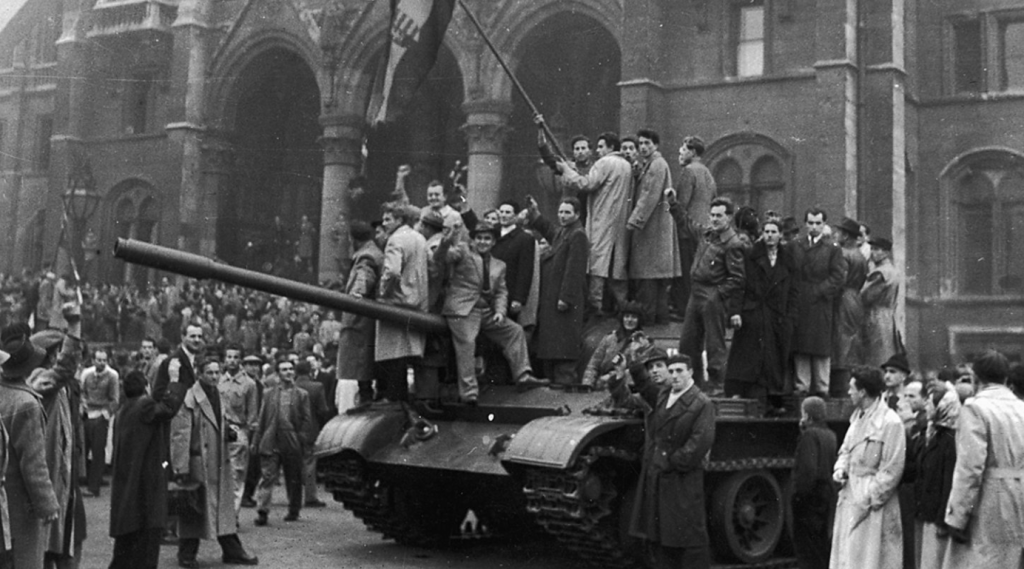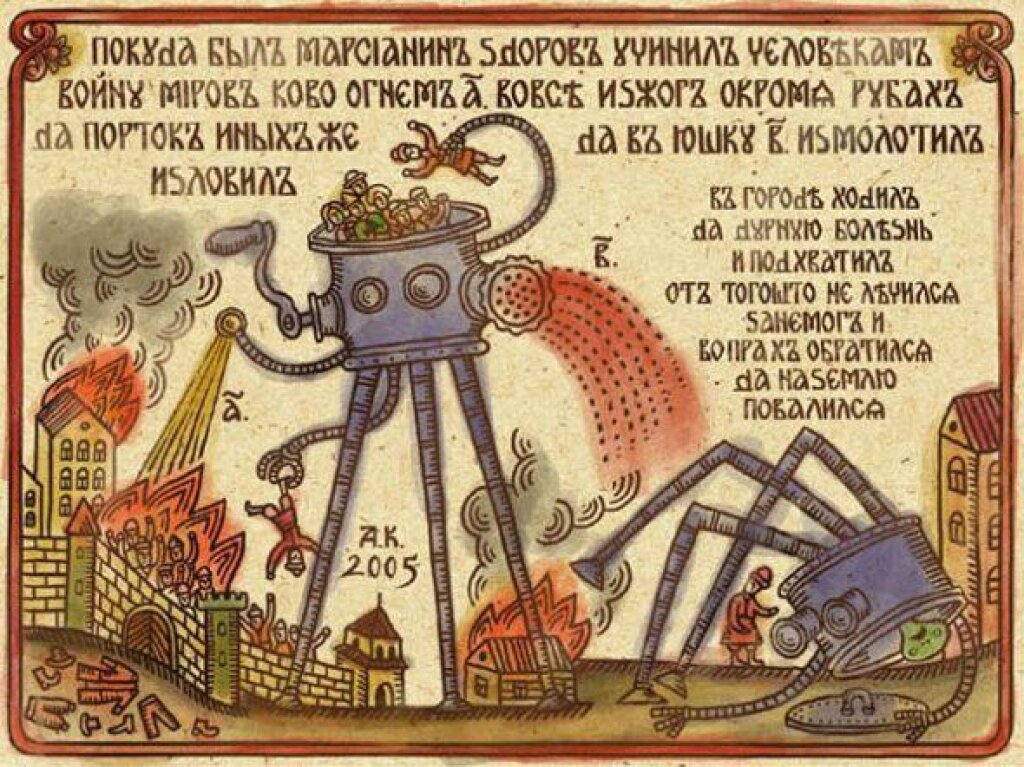Above: Soviet tanks in Budapest, 1956
Andreea Deciu Ritivoi is a Professor at Carnegie Mellon University.
We live on a steady diet of media stories and images of refugees desperate to escape atrocities in their own lands. We see refugees trying to get on a boat, only to drown later; to climb over a wall, or more recently, to cling on to an airplane already lifting up into the air. They desperately need to be rescued. But what if their rescue, or promise thereof, becomes a political ploy for Western powers to show off their compassion, camouflaging self-interest or other political maneuvers? A cautionary tale from the Cold War might remind us that narratives of rescue, which promise to overturn repressive regimes and bring freedom and democracy in other nations, can be a moral alibi for abandonment.
In the early days of the Cold War, George Kennan, the architect of containment, devised a plan for using political refugees from the Eastern Bloc as political and psychological warfare, a conduit to riling up the Eastern European nations against the Soviet-controlled regimes in their countries, and eventually against the Soviet Union. It was to be a win-win plan: the refugees would gain political and financial support from the United States government, and the US would gain entry behind the Iron Curtain and into the minds of Eastern Europeans. What began as a story of rescue turned into a story of abandonment. In 1956, on the streets of Budapest, Hungarians learned that the Americans were not coming. The popular movement that had briefly ousted Mátyás Rákosi’s communist regime was brutally suppressed by Soviet tanks. Over 2,000 Hungarians were killed, and over 200,000 defected. The United States government did not intervene and offered no concrete help to the Hungarians who attempted to change the political fate of their country. Widely criticized as disinterest or diplomatic mismanagement, this inaction reveals the pitfalls of a politics of rescue.
If we ponder Kennan’s rhetoric in proposing this plan—his word choice, turns of phrase, tone, sequence of the argument—we get some interesting insights into how US officials perceived the promised rescue mission. In his memo addressed on April 30, 1948, to the Policy Planning Council at the State Department, Kennan introduced the plan by first criticizing the United States for being “handicapped by popular attachment to the concept of basic difference between peace and war, […] by a tendency to view war as a sort of sporting contest outside of all political context.”
Kennan had a point: nothing less resembled a “sporting contest” than the Cold War. If the US could not adjust to a new kind of confrontation, how could it win? Kennan also had a solution. With US support, the refugees could “foment unrest” inside Eastern Europe and inspire mass movements against communism. Using the refugees as a mouthpiece, the US could covertly instigate and lead an uprise against the Soviet-controlled regimes in the satellite countries, and thus beat communism from inside the beast’s belly. The Eastern European refugees could then return, like Odyssean exiles, to their homelands and to a life of peace of freedom.
It was, of course, not so simple. The actual end of the Cold War, half a century later, was followed by painful and prolonged transitions to democracy, and many former exiles or dissidents fell into disgrace and disrepute rather than being hailed as heroes.
In Kennan’s memo, the phrase “not wholly acceptable” is crossed out in the original text, from the description of how political warfare was perceived in American politics, and replaced with “relatively unfamiliar.” The Cold-War politics of deception comes through in this one simple revision. With a stroke of the pen, the memo glossed over the ethics of instigating anti-communist uprisings in Eastern Europe without any plans to offer backup. If encouraging refugees to instigate revolt was “unfamiliar” rather than “unacceptable,” then pursuing the plan required not justification, but presentation. Kennan explained that both the Soviet Union and Germany, during the Second World War, had relied on “white propaganda” and “black psychological warfare.” Indeed, the political use of refugees was hardly a new idea even for the United States government. The refugees who would become part of Kennan’s plan were not as famous as the German scientists and intellectuals who worked for Office for Secret Services during World War II. But these Eastern European refugees became collectively famous as the voices of Radio Free Europe (RFE), one of the most influential Cold War institutions.
RFE broadcasts to Eastern Europe began in 1950, but already in July 1948 Secretary of State George Marshall had raised the possibility of using refugees in Voice of America broadcasts to Eastern Europe. US ambassadors in the region unanimously dissuaded him. Refugees speaking for the United States’ official government agency would be too much of a provocation to the Soviets. Kennan’s plan, on the other hand, kept the US government out of the public eye, or presented it as simply helping refugees maintain “communication with their homelands.” Keeping the US government behind the scenes was deemed essential. At an August 26, 1948 meeting, Kennan, along with several State Department officials, some of whom have had their names redacted from the declassified document, agreed on the need for “precautions to protect […] the US Government from any identifiable connection” with the plan. If Radio Free Europe was run by private citizens helping refugees, it would "hit the Communists hardest behind the Iron Curtain where it hurts them the most,” as CIA director Walter Bedell would proclaim in 1954.
The “private citizens” overseeing RFE, known as the National Committee for a Free Europe, which was formed in 1949, were highly public figures, such as former undersecretary of state Joseph Grew (who was the first chairman of the committee), Dewitt Clinton Poole, General Lucius Clay, and future president Dwight Eisenhower; also, Hollywood and media giants like Cecil B. DeMille and Henry Luce, among others. Speaking to the press, the committee chairman presented the refugees as “independent witnesses to the worth of our American endeavor. […who] can testify to what the trial of freedom and democracy in the United States has brought.” The refugees could attest, for the benefit of their fellow nationals behind the Iron Curtain, that the US was superior to the Soviet Union. Mouthpieces and missionaries for American democracy more than liberators of their own countries, these refugees were given a part in the Cold War political theatre, in which secrecy and disguises were essential props. The drama was staged by a government playing the role of "defender of the free world."
Throughout the Cold War, RFE was consistently a powerful presence in the lives of Eastern Europeans, who tuned to it to hear familiar voices, delivering in their own languages, a message of hope that the end of communism was near. The listeners glomming on to their radios to hear the voices of RFE broadcasters, thus engaging in risky clandestine activity, also heard something else. They heard what they took to be the sympathy and support of private Americans who believed in their suffering and wished to alleviate it. Such was the carefully staged effect of RFE’s broadcasts, a mask from behind which the United States could fight against the Soviet Union a war without American casualties.
In his original memo, Kennan had described refugees as allies and partners. He named them, or at least some of them, such as (Stanislaw) Mikolajczyk, Polish prime-minister in exile during the Second World War. Later documents contain no further names of refugees, an anonymity that engendered disparagement rather than sympathy. State Department officials who oversaw the implementation of the plan criticized the refugees for being prone to strife and in need of supervision. Rather than being named, refugees are identified in vague terms like “intellectual and political leaders who have come temporarily to this country, seeking the freedom denied them in their own lands;” “beleaguered people;” “foreign friendly elements.” These euphemisms do not depict an ally or partner, but rather an irksome, unnamed, victim. Lumped together into one generic category that is mainly recognizable as "foreign," the refugees lose their autonomy as political agents. Behind the Iron Curtain, RFE made their voices heard despite the socialist regimes’ jamming and blocking. In the West and to their presumed supporter and rescuer, the United States government, the refugees’ voice was inaudible.
Let’s go back to the voice we do hear loud and clear in the original document: Kennan’s. He had chosen his words carefully from the very beginning of his plan. The connotations of abnormality and weakness in the phrase “handicapped” were there to frighten and repel, as well as to suggest that a vigorous body politic should above all be concerned with its own well-being rather than with the fate of others.
To Kennan, there was hardly a choice between self-defense and rescuing others. For Kennan and his colleagues, the refugees were “metonymic emblems,” to use Larry Wolff’s term for attachments to particular individuals or groups that become stand-ins for entire nations. Wolff coined this phrase to describe Woodrow Wilson’s support for countries like Poland or Czechoslovakia as a by-product of his connections with leaders like Ignacy Jan Paderewski or Tomáš Masaryk, who had lived in, or paid consequential visits to, the United States.
Frank Wisner, who took over Kennan’s original plan once he became director of OPC, had lived in Bucharest, Romania during World War II. He saw first-hand the Soviet-ordered deportation of ethnic Germans to labor camps in the Soviet Union—an unforgettable, haunting experience that surely influenced his moral commitment to help Eastern Europeans. Years later, one of Wisner’s Romanian friends contacted him and described the deterioration of the country and terror brought by the Soviet-backed communist regime. This friend was asking for help—Wisner’s, but more broadly, the help of the United States government.
In 1965, a decade after the failed Hungarian Revolution, Frank Wisner committed suicide at his family’s vacation home. Scott Anderson has documented the reaction of Wisner’s associates, who had suspected untreated depression or professional burnout. Or was it a guilty conscience, and the buildup of disappointment in the hypocrisy of his government and country, who had promised help (even if implicitly) while planning all along to pursue only its own interests? We cannot know for sure what, if any, regrets or sense of culpability plagued any of the State Department officials; or if their private consciousness struggled with the hypocrisy of a foreign policy that pursued and justified covert operations in the guise of a politics of rescue. Perhaps most saw themselves as simply involved in political realism, as Kennan had argued all along, rather than as hypocrites promising universal rescue.
Hannah Arendt’s definition of political hypocrisy might shed further light on this question. For her, the hypocrite is not merely a liar or a phony, but someone who internalizes the pretense, buys into it, and holds on both publicly and privately to the insincere beliefs. These beliefs become a moral blazon that needs constant maintenance work. In 1956, amidst congressional debates and investigations—including a CIA investigation focused on RFE— in the role of the United States government in inciting the Hungarian Revolution, the moral and political virtues of a hands-off approach were repeatedly invoked and defended. How to maintain the belief that the United States is the defender of the free world, alongside inaction? Is there such a thing as a hands-off rescue? Dismissive of the refugees they deemed politically inept and disorganized, US officials could be just as dismissive of the needs of the refugees’ nations. But the moral beacon of a politics of rescue offered a strong alibi: the US had, after all, trusted the refugees to liberate their own countries.
The Hungarians were not the only Eastern Europeans let down in their hopes of a Western or American rescue during the Cold War. Others have been disappointed since then. Whenever we are forced to admit that, contrary to beliefs and expectations, the Americans are not coming, we might perhaps also consider that a politics of rescue is a “rescue” from remorse.



